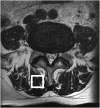Magnetic resonance spectroscopic analysis of multifidus muscles lipid content and association with spinopelvic malalignment in chronic low back pain
- PMID: 28291378
- PMCID: PMC5605103
- DOI: 10.1259/bjr.20160753
Magnetic resonance spectroscopic analysis of multifidus muscles lipid content and association with spinopelvic malalignment in chronic low back pain
Abstract
Objective: To analyze intramyocellular lipids (IMCLs) and extramyocellular lipids (EMCLs) of the multifidus muscle (Mm) using MR spectroscopy in chronic low back pain (CLBP) and control groups and to identify correlations with spinopelvic alignment.
Methods: 40 patients (16 males, 24 females; mean age, 62.9 ± 1.9 years) whose visual analogue scale scores were >30 mm for CLBP were included. Furthermore, 40 control participants matched with the CLBP group subjects by sample size, gender and age (17 males, 23 females; mean age, 65.0 ± 1.2 years) were included. We compared the body mass index, physical workload, leisure time physical activity level, spinopelvic parameters, and IMCLs and EMCLs of the Mm between the groups. We also evaluated possible correlations of spinopelvic parameters with IMCLs and EMCLs of the Mm in the groups.
Results: There were no statistically significant differences in body mass index, physical workload, exercise intensity level, spinopelvic parameters and EMCLs between the groups. The IMCLs were significantly higher in the CLBP group than in the control group (p < 0.01). In the CLBP group, there was a significantly negative correlation between IMCLs and lumbar lordosis (r = -0.64, p < 0.01) and a significantly positive correlation between IMCLs and sagittal vertical axis (r = 0.43, p < 0.01).
Conclusion: The measurement of IMCLs might be a characteristic finding of CLBP as well as a precursor to spinal deformity. Advances in knowledge: IMCLs of the Mm may be a useful prognostic marker in rehabilitation strategies for patients with CLBP.
Figures






Similar articles
-
The Politics of Chronic LBP: Can We Rely on a Proxy-Vote? Linking Multifidus Intra-Myo-Cellular Lipid (IMCL) Fatty Infiltration With Arthrogenic Muscle Inhibition (AMI)-induced Chronic Nonspecific Low Back Pain.Spine (Phila Pa 1976). 2021 Jan 15;46(2):129-130. doi: 10.1097/BRS.0000000000003758. Spine (Phila Pa 1976). 2021. PMID: 33079906
-
Analysis of intra and extramyocellular lipids in the multifidus muscle in patients with chronic low back pain using MR spectroscopy.Br J Radiol. 2018 Feb;91(1083):20170536. doi: 10.1259/bjr.20170536. Epub 2018 Jan 2. Br J Radiol. 2018. PMID: 29227152 Free PMC article.
-
Comparison of MRI-defined back muscles volume between patients with ankylosing spondylitis and control patients with chronic back pain: age and spinopelvic alignment matched study.Eur Spine J. 2017 Feb;26(2):528-537. doi: 10.1007/s00586-016-4889-2. Epub 2016 Nov 24. Eur Spine J. 2017. PMID: 27885474
-
Factors Associated With the Ultrasound Characteristics of the Lumbar Multifidus: A Systematic Review.PM R. 2020 Jan;12(1):82-100. doi: 10.1002/pmrj.12212. Epub 2019 Sep 13. PM R. 2020. PMID: 31264799
-
The Association between Imaging Parameters of the Paraspinal Muscles, Spinal Degeneration, and Low Back Pain.Biomed Res Int. 2017;2017:2562957. doi: 10.1155/2017/2562957. Epub 2017 Mar 20. Biomed Res Int. 2017. PMID: 28409152 Free PMC article. Review.
Cited by
-
The association between morphological characteristics of paraspinal muscle and spinal disorders.Ann Med. 2023;55(2):2258922. doi: 10.1080/07853890.2023.2258922. Epub 2023 Sep 18. Ann Med. 2023. PMID: 37722876 Free PMC article. Review.
-
Spinal‑pelvic sagittal imbalance and paraspinal muscle degeneration in patients with degenerative lumbar spinal stenosis: A monocentric, prospective and observational study.Exp Ther Med. 2023 Aug 25;26(4):479. doi: 10.3892/etm.2023.12178. eCollection 2023 Oct. Exp Ther Med. 2023. PMID: 37745044 Free PMC article.
-
Associations between potentially modifiable clinical factors and sagittal balance of the spine in older adults from the general population.Spine Deform. 2022 Mar;10(2):433-441. doi: 10.1007/s43390-021-00435-y. Epub 2021 Nov 6. Spine Deform. 2022. PMID: 34741754
-
NIR-II Imaging Guided Accurate Identification of Paraspinal Muscle Degeneration Through Targeting the Lysosomal Membrane Protein Sidt2.Int J Nanomedicine. 2025 Jun 17;20:7743-7762. doi: 10.2147/IJN.S517633. eCollection 2025. Int J Nanomedicine. 2025. PMID: 40551976 Free PMC article.
-
Impact of skeletal muscle mass of the trunk and extremities on standing spine parameters before and after surgery for adult spinal deformity with a minimum 2-year follow-up.Eur Spine J. 2025 Mar;34(3):1026-1033. doi: 10.1007/s00586-024-08617-8. Epub 2025 Jan 15. Eur Spine J. 2025. PMID: 39812788
References
-
- Deyo RA, Weinstein JN. Low back pain. N Engl J Med 2001; 344: 363–70. doi: https://doi.org/10.1056/NEJM200102013440508 - DOI - PubMed
-
- Hurwitz EL, Morgenstern H. The effects of comorbidity and other factors on medical versus chiropractic care for back problems. Spine (Phila Pa 1976) 1997; 22: 2254–63; discussion 2263–4. - PubMed
-
- Shekelle PG, Markovich M, Louie R. An epidemiologic study of episodes of back pain care. Spine (Phila Pa 1976) 1995; 20: 1668–73. - PubMed
-
- Balague F, Mannion AF, Pellise F, Cedraschi C. Non-specific low back pain. Lancet 2012; 379: 482–91. - PubMed
-
- Cholewicki J, Panjabi MM, Khachatryan A. Stabilizing function of trunk flexor-extensor muscles around a neutral spine posture. Spine (Phila Pa 1976) 1997; 22: 2207–12. - PubMed
MeSH terms
Substances
LinkOut - more resources
Full Text Sources
Other Literature Sources

